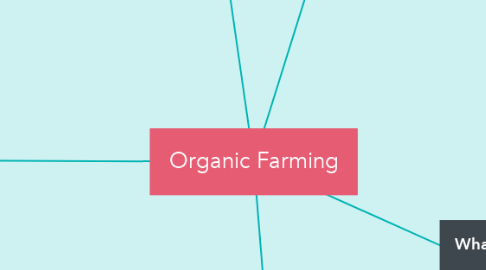
1. Method
1.1. Crop rotation
1.1.1. The practice of growing a series of different types of crops in the same area across a sequenced of growing seasons
1.2. Crop diversity
1.2.1. a form of agriculture in which more than one species is grown at the same time and place in imitation of the diversity of natural ecosystems.
1.3. Weed managment
1.3.1. preventing weed problems from arising with methods such as crop rotation, fertility building, intercropping, undersowing and more
1.3.2. a method of decomposing organic solid wastes, which is a beneficial fertilizer for plants.
1.3.2.1. 1.Aerobic composting uses oxygen and bacteria and replicates natural decomposition.
1.3.2.2. 2.Anaerobic composting is decomposition that occurs using microorganisms that do not require oxygen to survive.
1.4. Soil management
2. 4 Basic Principles
2.1. Principle of Health
2.1.1. Organic agriculture should sustain and enhance the health of soil, plant, animal, human and planet as one and indivisible.
2.2. Principle of ecology
2.2.1. Organic agriculture should be based on living ecological systems and cycles, work with them, emulate them and help sustain them.
2.3. Principle of fairness
2.3.1. Organic agriculture should build on relationships that ensure fairness with regard to the common environment and life opportunities.
2.4. Principle of care
2.4.1. Organic agriculture should be managed in a precautionary and responsible manner to protect the health and well-being of current and future generations and the environment
3. Factor
3.1. Ecological Factor
3.1.1. soil fertility, biodiversity, water supply, location, temperature, climate, humidity,light intensity, and nutrients available.
3.2. Technical Factors:
3.2.1. crop-type and species, land availability, specific management practices adopted, and access to resources for the farmers.
4. History
4.1. Agriculture has always been our way of life since the very beginning of human civilization
4.2. However, The Industrial Revolution & Society development lead to a higher demand for food
4.2.1. which lead to conventional farming
4.2.1.1. Higher yield
4.2.1.2. Environmental, health problems
4.3. Organic farming is consider a solution to these problems
4.3.1. Why ?
4.3.1.1. It ban the use of harmful chemical substances on crops
5. What is it ?
5.1. Definition
5.1.1. a farming method that involves growing and nurturing crops without the use of synthetic based fertilizers and pesticides
5.1.2. A production system that sustain the health of soil, ecosystem and people
5.1.3. Rely on ecological processes, biodiversity, and cycles adapted to local conditions, rather than the use of inputs with adverse effects
5.2. GOAL
5.2.1. Maintain the sustainable ecosystem
5.2.2. Promote the usage of renewable resources and harmonious balance between animals and crop
5.2.3. Improve their lives by generating higher income through lower production costs and higher price outputs
5.2.4. Increase fertility of the soil, and the genetic diversity of ecosystem
5.3. Cons
5.3.1. Lower yield because more product is damaged by pests
5.3.2. expensive for most people
5.3.3. Require more resources than conventional farming method
5.4. Pros
5.4.1. better for consumer health
5.4.2. Reduce climate change
